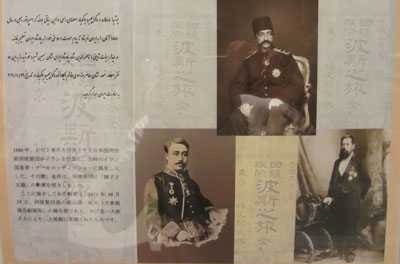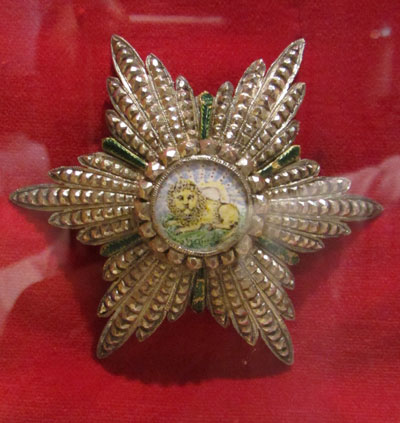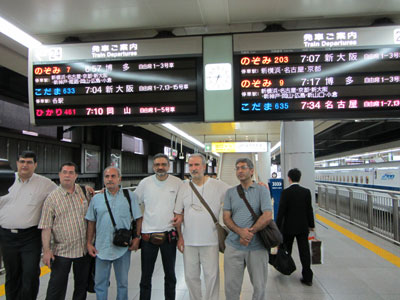Hiroshima Travelogue - Episode 6
A set of pictures get your attention at the newly-built hall of Iran’s embassy. The structure was added to the Iranian embassy’s complex about 11 years earlier. The set comprises three historical shots, two Persian and Japanese captions and a badge; Nasseredin Shah, Masaharu Yoshida and MagoichirŠYokoyama are in the shots, and the badge is the Iranian Order of the Lion and the Sun. The caption reads as follows:
“Masaharu Yoshida and MagoichirÅ Yokoyama were members of the first official delegation sent to Iran in 1880 by Emperor Meiji to transfer the message of friendship to the Iranian king. During a meeting, the Iranian king offered the two Japanese messengers a silver order of the Lion and the Sun. The badge was offered to the Iranian embassy by Mrs. Ikawa, a granddaughter of MagoichirÅ Yokoyama, on 29/10/2011.â€

The 7-strong delegation, which included a translator and four merchants as well, entered Bushehr port on June 7, 1880 and then moved to Shiraz. They spent their 45-day stay in Shiraz cruising the city and visiting historical buildings. On September 27, 1880, the delegation met with Nasseredin Shah at Shams-ul-Emareh (the Sun Mansion). Masaharu Yoshida’s speech at the meeting is well organized and palatable to the Iranian king. It reads as follows:
“His sublime Excellency the Japanese Emperor has authorized me to extend his most sincere desire and determination to sustain the amicable relations between the two governments which are now strengthened by the Japanese delegation and shall be continued to the end.â€
I understand that the wish by the Japanese emperor has been realized given the sustain Iran-Japan relations which have remained friendly since then, except during the Second World War when the young Iranian king engaged in scuffles with the Axes which undermined tie with Japan.


July 25
We are on our way to Hiroshima on a bullet train: Shinkansen. They say it is 300-km fast. We rush to the station. The train sets off at 6:57. The timing is exact and unalterable. This very discipline prompted us to cut short of our dawn slumber and move to the station. They say they once delayed the train for a VIP for him to take the train; the parliament and the government cabinet reacted severely to the move, fired some and punished some others. We have to admit progress and development cannot be attained without discipline. Utopias can be reached only when anomalies are gotten rid of.
After a short while, the train officer who checks the tickets steps in the wagon with almost 100 seats. As he enters, he takes his hat off in respect to the passengers and bows. He takes the tickets one by one, punches them and thanks every single one of the passengers. No matter how many seats are in the wagon, he bows to each and every one of them. When exiting, he does the same, probably wishes a good trip to the passengers and leaves, disregarding the fact that everyone’s back is to him.
Hedayatollah Behboudi
Translated by: Abbas Hajihashemi
Number of Visits: 6099








The latest
- Objects Tell What Happened in the Eight-Year War!
- 100 Questions/6
- Comparative Analysis of Women’s and Men’s Written Memoirs in the Sacred Defense
- The Importance of Pre-Publication Critique of Oral History Works
- Third Regiment: Memoirs of an Iraqi Prisoner of War Doctor – 6
- 100 Questions/5
- Complete Harmony Between Narrator and Author; the Defining Hallmark of “Beyond the Wall”
- Pepper Fragrance
Most visited
- 100 Questions/ 4
- Third Regiment: Memoirs of an Iraqi Prisoner of War Doctor – 5
- Challenges of Interviewing in Oral History
- Complete Harmony Between Narrator and Author; the Defining Hallmark of “Beyond the Wall”
- Pepper Fragrance
- 100 Questions/5
- Third Regiment: Memoirs of an Iraqi Prisoner of War Doctor – 6
- The Importance of Pre-Publication Critique of Oral History Works
Mohammad — The Messiah of Kurdistan
Boroujerdi immediately said to Darvish, “Ready a few men; we’re going.” Then he moved toward Mostafa, who was studying the Kurdistan map. Mostafa straightened his back and said, “During my service in the army I experienced a full-scale war in Kurdistan. Guerrilla warfare in Kurdistan follows its own rules. The anti-revolutionary commanders want to draw us into a battle chosen on their terms.”From Javanrud to Piranshahr
The Memoir of Reza MohammadiniaThe book From Javanrud to Piranshahr recounts the life and struggles of Commander Reza Mohammadinia, who spent part of the Iran–Iraq War in the western and northwestern regions of the country. During those years, he held responsibilities such as deputy commander of the Seventh Region of the Islamic Revolutionary Guard Corps (IRGC), acting head of the Javanrud district, service on the southern fronts, director of ...
Tactical and Strategic Analysis and Limitations
The present paper, entitled “A Critical and Scholarly Study of Dr. Hossein Alaei’s Two-Volume Book: Tactical and Strategic Analysis and Limitations”, is a research work that examines and evaluates the two-volume book “An Analytical History of the Iran-Iraq War”. In this study, the strengths and weaknesses of the work are analyzed from the perspectives of content critique, methodology, and sources.

